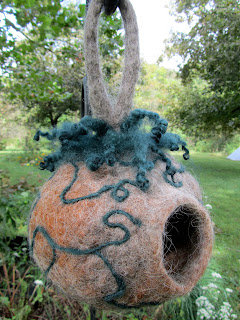Here in mid-Missouri Summer held on tightly until her very last day, keeping the heat and humidity cranked up. Then an overnight thunderstorm swept all that away, and Autumn arrived exactly on schedule, pulling a few first treasures out of her trunk. These first days of the "official" fall season have been perfect, absolutely perfect. Clear, dry, golden mornings when I can step out on the back porch, gladly breath in the cool, crisp air, and realize that the warm cup of coffee feels welcome to my fingers. On such a day I have no choice but to grab the camera and take in some of the sights on the first days of autumn.
The rose turtleheads have thrived in all our summer rain. From a couple of transplants two years ago, there is now a growing colony at the pond's edge. I love to gently squeeze one of the blooms and watch the "turtle" open his mouth.
Among the turtleheads is one wild senna plant. It also loves wet feet but does not seem to spread. I'm going to save the seed pods (those green beany shapes) this year and try to propagate more next spring. Both the turtleheads and senna are native wildflowers.
There are still plenty of butterflies around. I found this one in the woods, sunning itself on a leaf. It has two common names - Question Mark or Violet Tip butterfly, Latin name - Polygonia interrogationis.
While in the woods, I came upon loads of mushrooms. All the rain and warm temperatures of the last week have brought on a huge fruiting in the fungi community. Wildflowers and butterflies are a piece of cake to identify, compared with mushrooms. In addition to all the bizarre and colorful varieties, I love the challenge of trying to ID a mushroom. I haven't had time to really study the photos I took on my walk, but check out all this wonderful weirdness.
They're certainly interesting, but aren't you thankful for chlorophyll-producing lifeforms?
What would early autumn be without masses of goldenrod with all those bumblebees nosing around them?
Yeah, I couldn't resist a shot of the old truck nearly buried in vegetation. Once a couple of years ago, I walked up to it and startled a handsome red fox out of the passenger seat. I still enjoy pulling that image up in my memory.
One final photo of these brilliant red berries. They are the fruit of the Autumn Olive tree. Pretty to be sure, and probably a good food source for wildlife. But it's a non-native, very invasive tree. The animals help spread its seeds hither and yon. There is far too much of it in the pasture and elsewhere, and it's difficult to eradicate. So, for me, the beauty of those sprays of berries is always tempered by what I know of the plant's true nature.
As usual it's wonderful to welcome in a new season. Like spring, autumn has a special feeling, a kind of easy comfort after the harshness of the previous months. Step outside and see what Autumn has brought for her stay. You know there are still more wonders to come.
Take care. Be well.






















